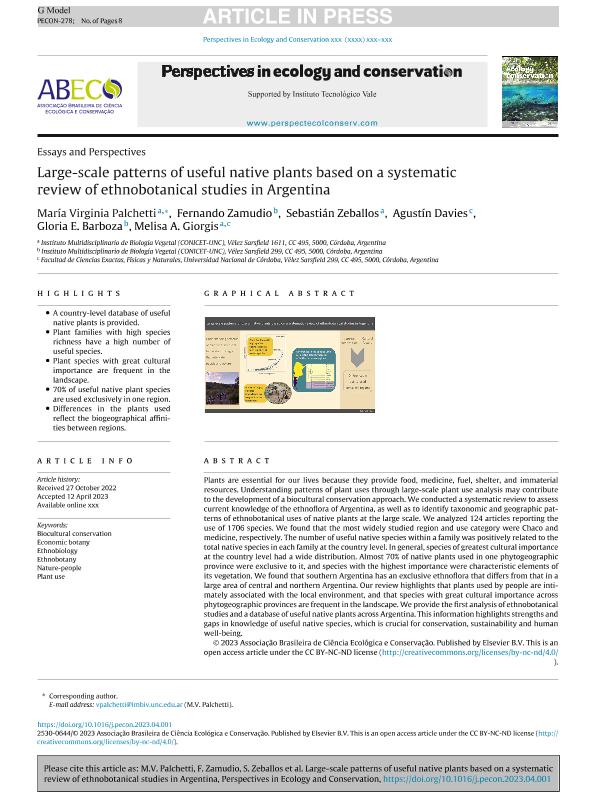Mostrar el registro sencillo del ítem
dc.contributor.author
Palchetti, Maria Virginia

dc.contributor.author
Zamudio, Fernando

dc.contributor.author
Zeballos, Sebastián Rodolfo

dc.contributor.author
Davies, Agustín

dc.contributor.author
Barboza, Gloria Estela

dc.contributor.author
Giorgis, Melisa Adriana

dc.date.available
2023-11-28T13:58:28Z
dc.date.issued
2023-04
dc.identifier.citation
Palchetti, Maria Virginia; Zamudio, Fernando; Zeballos, Sebastián Rodolfo; Davies, Agustín; Barboza, Gloria Estela; et al.; Large-scale patterns of useful native plants based on a systematic review of ethnobotanical studies in Argentina; Associacao Brasileira de Ciencia Ecologica e Conservacao; Perspectives in Ecology and Conservation; 21; 2; 4-2023; 93-100
dc.identifier.issn
2530-0644
dc.identifier.uri
http://hdl.handle.net/11336/218661
dc.description.abstract
Plants are essential for our lives because they provide food, medicine, fuel, shelter, and immaterial resources. Understanding patterns of plant uses through large-scale plant use analysis may contribute to the development of a biocultural conservation approach. We conducted a systematic review to assess current knowledge of the ethnoflora of Argentina, as well as to identify taxonomic and geographic patterns of ethnobotanical uses of native plants at the large scale. We analyzed 124 articles reporting the use of 1706 species. We found that the most widely studied region and use category were Chaco and medicine, respectively. The number of useful native species within a family was positively related to the total native species in each family at the country level. In general, species of greatest cultural importance at the country level had a wide distribution. Almost 70% of native plants used in one phytogeographic province were exclusive to it, and species with the highest importance were characteristic elements of its vegetation. We found that southern Argentina has an exclusive ethnoflora that differs from that in a large area of central and northern Argentina. Our review highlights that plants used by people are intimately associated with the local environment, and that species with great cultural importance across phytogeographic provinces are frequent in the landscape. We provide the first analysis of ethnobotanical studies and a database of useful native plants across Argentina. This information highlights strengths and gaps in knowledge of useful native species, which is crucial for conservation, sustainability and human well-being.
dc.format
application/pdf
dc.language.iso
eng
dc.publisher
Associacao Brasileira de Ciencia Ecologica e Conservacao
dc.rights
info:eu-repo/semantics/openAccess
dc.rights.uri
https://creativecommons.org/licenses/by-nc-sa/2.5/ar/
dc.subject
BIOCULTURAL CONSERVATION
dc.subject
ECONOMIC BOTANY
dc.subject
ETHNOBIOLOGY
dc.subject
ETHNOBOTANY
dc.subject
NATURE-PEOPLE
dc.subject
PLANT USE
dc.subject.classification
Conservación de la Biodiversidad

dc.subject.classification
Ciencias Biológicas

dc.subject.classification
CIENCIAS NATURALES Y EXACTAS

dc.title
Large-scale patterns of useful native plants based on a systematic review of ethnobotanical studies in Argentina
dc.type
info:eu-repo/semantics/article
dc.type
info:ar-repo/semantics/artículo
dc.type
info:eu-repo/semantics/publishedVersion
dc.date.updated
2023-10-23T13:31:09Z
dc.journal.volume
21
dc.journal.number
2
dc.journal.pagination
93-100
dc.journal.pais
Brasil

dc.description.fil
Fil: Palchetti, Maria Virginia. Consejo Nacional de Investigaciones Científicas y Técnicas. Centro Científico Tecnológico Conicet - Córdoba. Instituto Multidisciplinario de Biología Vegetal. Universidad Nacional de Córdoba. Facultad de Ciencias Exactas Físicas y Naturales. Instituto Multidisciplinario de Biología Vegetal; Argentina
dc.description.fil
Fil: Zamudio, Fernando. Consejo Nacional de Investigaciones Científicas y Técnicas. Centro Científico Tecnológico Conicet - Córdoba. Instituto Multidisciplinario de Biología Vegetal. Universidad Nacional de Córdoba. Facultad de Ciencias Exactas Físicas y Naturales. Instituto Multidisciplinario de Biología Vegetal; Argentina
dc.description.fil
Fil: Zeballos, Sebastián Rodolfo. Consejo Nacional de Investigaciones Científicas y Técnicas. Centro Científico Tecnológico Conicet - Córdoba. Instituto Multidisciplinario de Biología Vegetal. Universidad Nacional de Córdoba. Facultad de Ciencias Exactas Físicas y Naturales. Instituto Multidisciplinario de Biología Vegetal; Argentina
dc.description.fil
Fil: Davies, Agustín. Universidad Nacional de Córdoba. Facultad de Ciencias Exactas, Físicas y Naturales; Argentina
dc.description.fil
Fil: Barboza, Gloria Estela. Consejo Nacional de Investigaciones Científicas y Técnicas. Centro Científico Tecnológico Conicet - Córdoba. Instituto Multidisciplinario de Biología Vegetal. Universidad Nacional de Córdoba. Facultad de Ciencias Exactas Físicas y Naturales. Instituto Multidisciplinario de Biología Vegetal; Argentina
dc.description.fil
Fil: Giorgis, Melisa Adriana. Consejo Nacional de Investigaciones Científicas y Técnicas. Centro Científico Tecnológico Conicet - Córdoba. Instituto Multidisciplinario de Biología Vegetal. Universidad Nacional de Córdoba. Facultad de Ciencias Exactas Físicas y Naturales. Instituto Multidisciplinario de Biología Vegetal; Argentina. Universidad Nacional de Córdoba; Argentina
dc.journal.title
Perspectives in Ecology and Conservation
dc.relation.alternativeid
info:eu-repo/semantics/altIdentifier/url/https://www.sciencedirect.com/science/article/pii/S2530064423000251
dc.relation.alternativeid
info:eu-repo/semantics/altIdentifier/doi/https://doi.org/10.1016/j.pecon.2023.04.001
Archivos asociados
